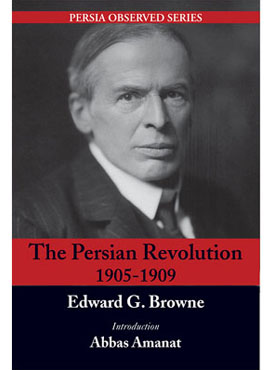About the Book
“Many dangers and many anxious days lie without doubt before the new Persia.”
More than eight decades later, Edward Browne’s fears and hopes have a special resonance in the minds of contemporary readers. The Persian Revolution of 1905-1909, an account of one episode in Iran’s eventful annals, has maintained its relevance and freshness, even after the occurrence of a revolution more intense and all-embracing than the Constitutional Revolution of 1906-11. When the aspirations of the Constitutional period are contrasted with those of the more recent revolution, the irony is poignant and inescapable, especially when it is noted that the occurrence of the second revolution was a distant protest against the failure of the first.
What Browne primarily intended to achieve in his book was to allow the voice of the Persian people to be heard by his Western audience. He tried to demonstrate to his readers that the tumultuous events they were witnessing in Iran, often with suspicion if not disdain, were in fact no less than a genuine struggle by an oppressed and impoverished nation to establish a constitutional order despite the overwhelming odds of domestic tyranny, foreign intervention, and ideological divisions. The Persian Revolution was more than a simple record of a revolution, for it influenced the very course of events it covered in its pages.
An essential volume for anyone attempting to understand Persia’s past and present, this new edition features an introduction by Abbas Amanat, Browne’s correspondences, and contemporary reviews of the book, all of which provide a rich context for The Persian Revolution of 1905-1909. Also included are 56 period photographs.
Note: This book was originally published in 1910 by Cambridge University Press.
Reviews
“There can be no doubt of the permanent value of the book…”
- New York Times (1911)
“Browne labours to show that the Persian Revolution was no mere isolated phenomenon, but one form of a movement which is affecting Islam.”
- Manchester Guardian (1910)
“No history of events in Persia between the years 1905 and 1909 is ever likely to compete with this.”
- The Spectator (1910)
“A large amount of information which is of the upmost value…”
- The London Times (1911)
” In this account of Iran’s Constitutional Revolution, British Orientalist Edward G. Browne portrays Persia as a nation oppressed by its leadership and foreign interests, struggling to establish a constitutional government. In the introduction to this reprint of the 1910 edition, Abbas Amanat writes that Browne’s description is unique in that, amidst a time of imperialism and orientalism, it speaks sypathetically of a nation’s aspirations to shape its own political system.”
- Middle East Journal
Excerpt
The Marie Petit affair
At the beginning of the 18th century, Louis XIV and his ministers decided to send an ambassador to Persia. Their choice fell on Jean-Baptiste Fabre, a merchant from Marseilles who had lived in Constantinople for a long time but was then in France. To impress the court of the Sophy they conferred on him the title of Ambassador Extraordinary. He left Marseilles in March 1705…
To combine business with pleasure, Fabre also decided to take his mistress, the adventurous Marie Claude Petit, with him to Isfahan. An account of the extravagant incidents and scandals that followed as a result would lead us too far from our subject. Suffice it to say that the sudden death of Fabre, some time after his arrival in the Persian city of Erivan, far from subduing Marie, fanned the flame of her ambitions.
Snapping her fingers at the traveling companions’ choices of a successor for Fabre, she proclaimed herself head of the mission “in the name of the princesses of France” and took possession not only of the over’s personal effects, but also of the presents for the Shah and the documents of the mission.
Meanwhile news of Fabre’s death and of the subsequent events in Erivan had reached Ferriol, the French ambassador to Constantinople. Without waiting for orders from France, he at once dispatched his young secretary Pierre-Victor Michel to Persia, with orders to overtake the mission, to take charge of it and to send Marie Petit back to France.
Michel caught up with the mission in Tabriz. However, he was unable to dislodge Marie, as she was now under the protection of the city’s Governor, as a result of a letter of recommendation from the Khan of Erivan. Having talked to her and thinking that he had persuaded her to stay in Tabriz while he went to see the Shah, Michel proceeded to the Persian court, which was then encamped some distance to the south of Tehran.
On his way, he stopped in Qazvin, where he was well received by the Governor. However, his satisfaction was short-lived, for the day after his arrival Marie Petit also reached that city, armed with letters of recommendation from the Khans of Erivan and Tabriz. As a result, she was allowed to go on to the court, while Michel had to remain in Qazvin.
On her arrival at court she was received by the Prime Minister, who conducted her to the royal harem, where according to her own account she received “all possible honors”. On the following day, after being given her congé by the Shah, she returned to Tabriz.
In the meantime Michel, after some delay, had also been able to make his way to court. However, having been prevented by his enemies from seeing anyone of importance, he was forced to retrace his steps. In Tabriz, he found Marie. She had been ill, and was in a chastened and contrite mood. Upon her humble request, he provided her with an escort and traveling money to return to France…
… Marie Petit was arrested upon her return to Marseilles in February 1709, and imprisoned in in a convent on charged of having scandalized the Orient by her behavior, planned to embrace Islam, misappropriated the presents intended for the Shah and caused the death of several Frenchmen. It was more than enough to have her condemned to the burnt at the stake.
However, upon Ferriol’s recall from Turkey in 1711, Fabre’s widow returned from Constantinople, and although she had every reason to hate her late husband’s mistress, she gave evidence on her behalf. It was probably her intervention which led the judicial authorities to take a more lenient view of Marie’s conduct, and in 1713 she was released.
About the Author
ABBAS AMANAT received his B.A. from Tehran University in 1971 and D.Phil. from Oxford University in 1981. His principal publications include Pivot of the Universe: Nasir al-Din Shah and the Iranian Monarchy, 1831-1896 (1997) and Resurrection and Renewal: the Making of the Babi Movement in Iran, 1844-1850 (1989). He is the editor of Cities and Trade: Consul Abbott on the Economy and Society of Iran (1983), Crowning Anguish: Memoirs of a Persian Princess from the Harem to Modernity (1995) and co editor of Imagining the End: Visions of Apocalypse from Ancient Middle East to Modern America (2002). He also edited The United States and the Middle East: Diplomatic and Economic Relations in Historical Perspective (2000) and co-edited The United States and the Middle East: Cultural Encounters (2002) and Apocalypse and Violence (2004). He is the editor of Mage’s Persia Observed Series, which includes Edward Browne’s The Persian Revolution of 1905-1909.
Abbas Amanat is a professor of history at Yale University.









